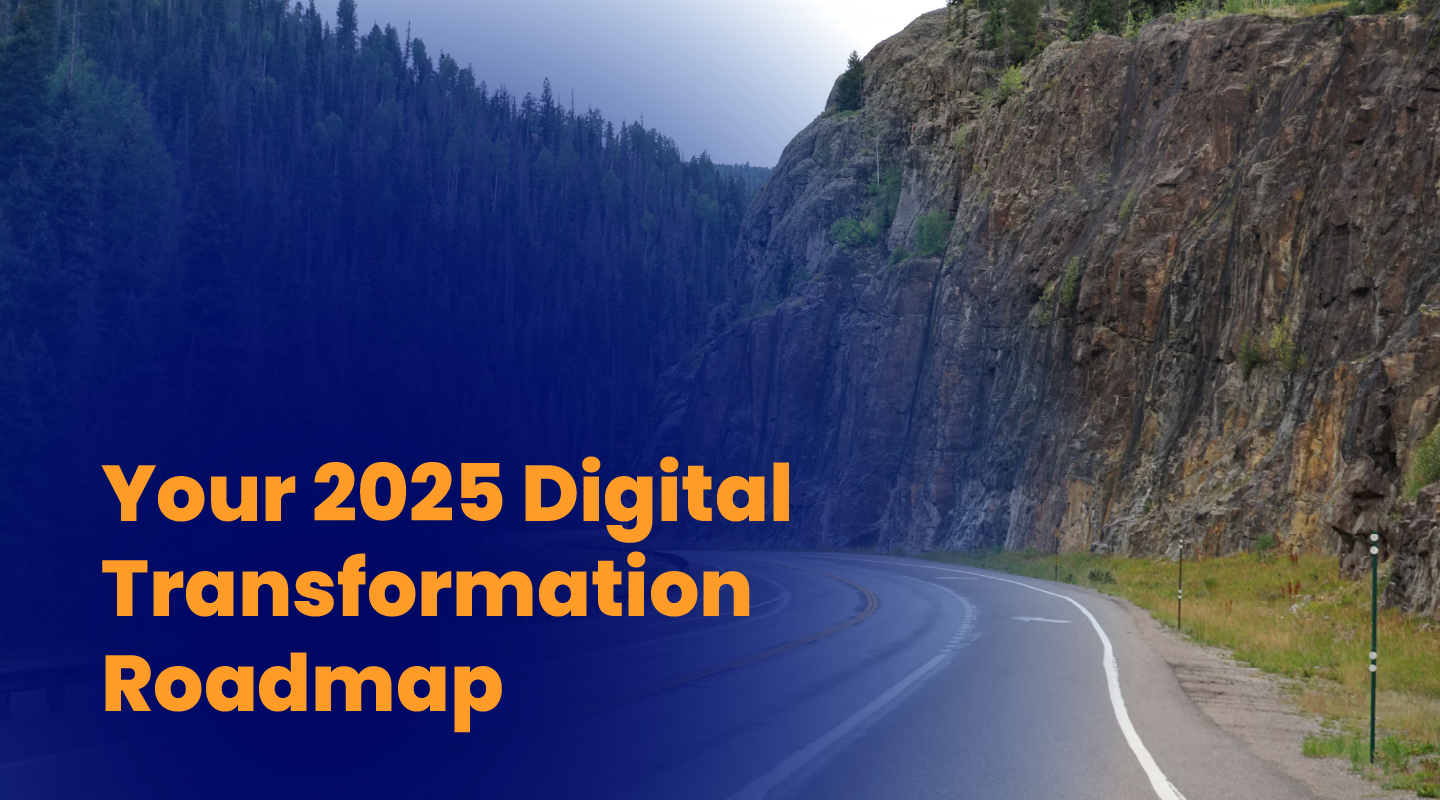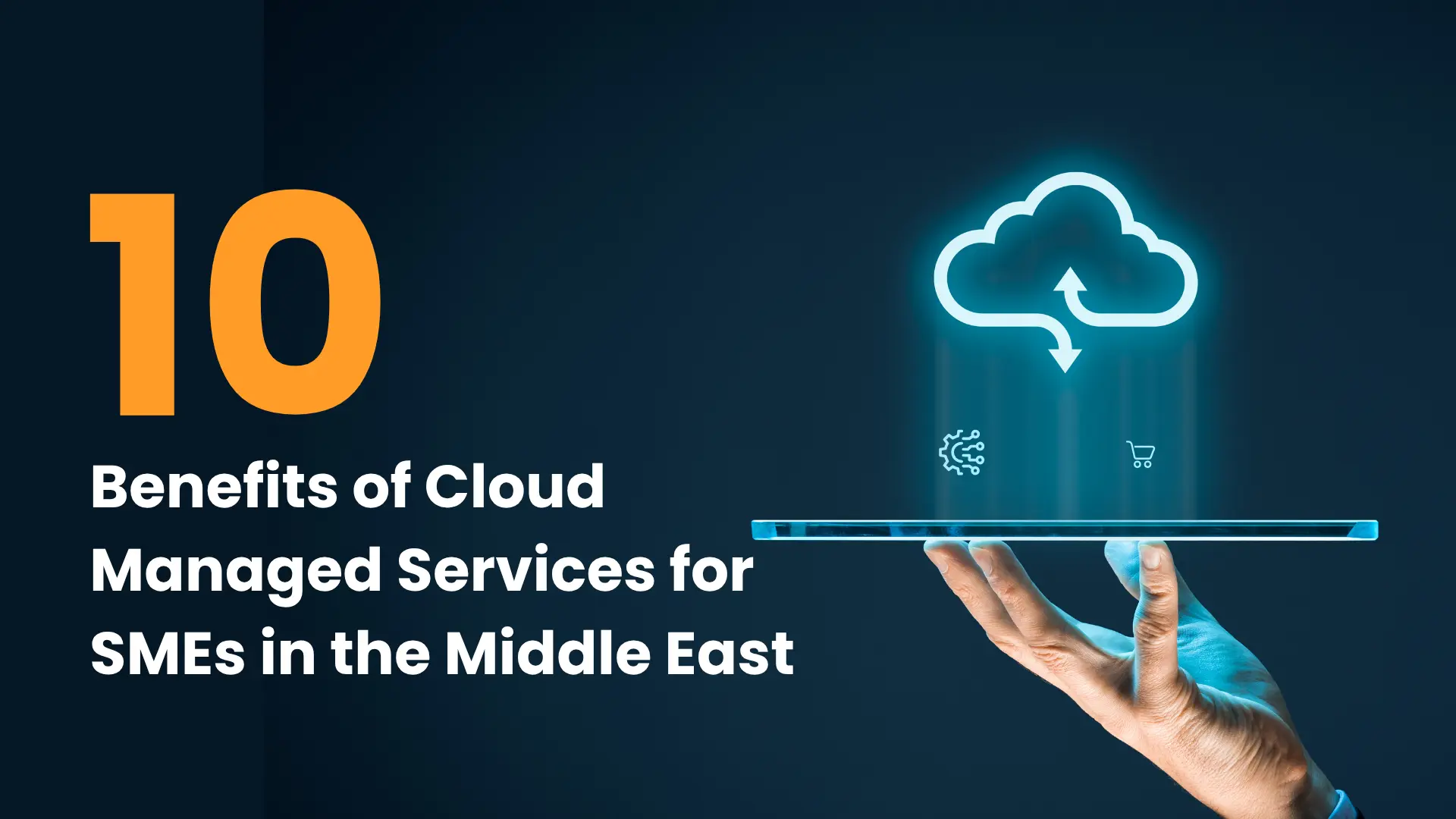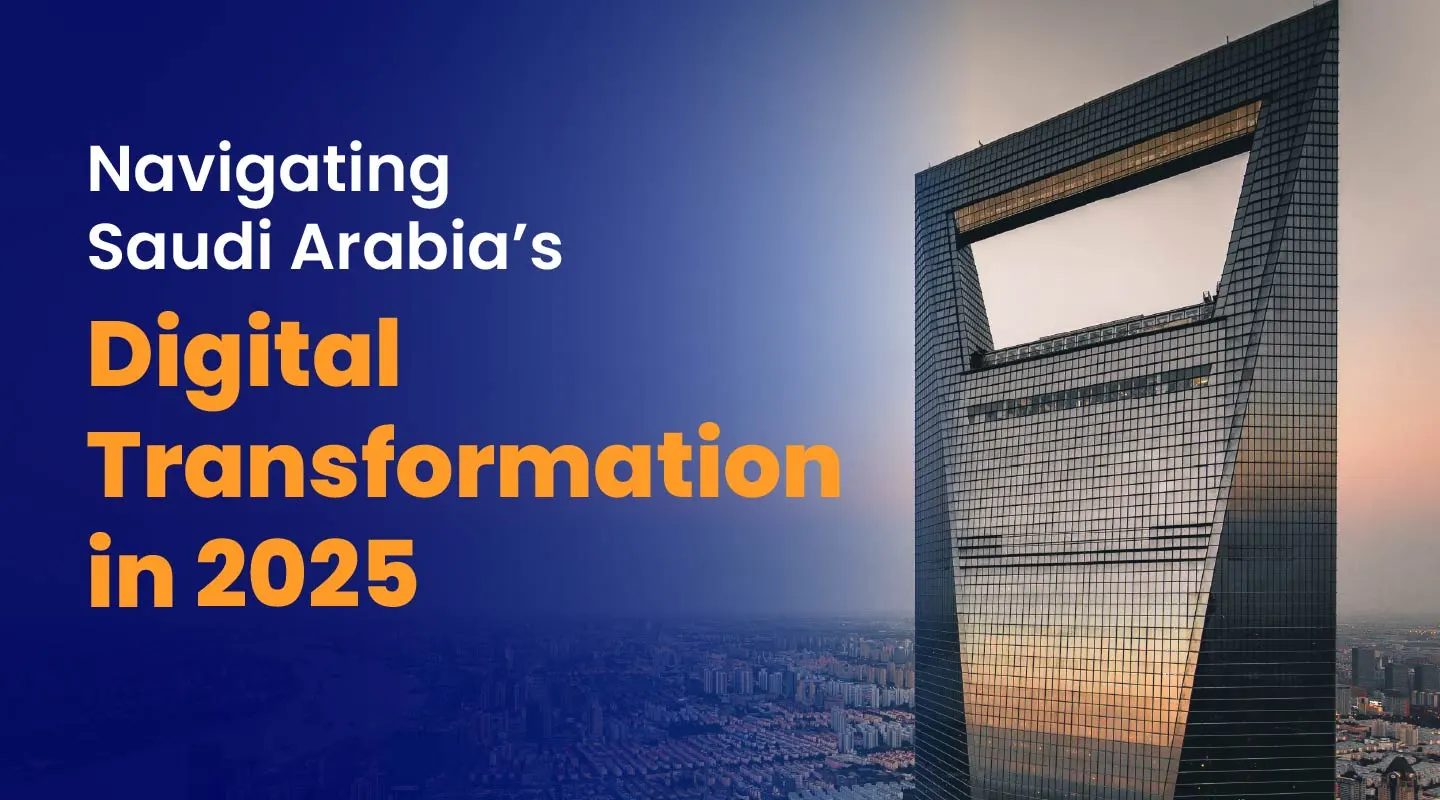Contents
- 1 At a Glance: Digital Transformation in the Middle East
- 2 Introduction: Why Middle East Businesses Need a Digital Transformation Roadmap
- 3 Digital Maturity Self-Assessment: Where Does Your Organization Stand?
- 4 Digital Maturity Levels & Next Steps:
- 5 Benefits of a well-drafted Digital Transformation Strategy
- 6 Rise in AI, Cloud, and Automation in the Region
- 7 How to Create a Digital Transformation Roadmap
- 8 How to Create a Digital Transformation Roadmap in 7 Steps
- 9 Key Considerations for Middle East Businesses Before Building a Digital Transformation Roadmap
- 10 Common Mistakes to Avoid while Building a Digital Transformation Roadmap
- 11 Digital Transformation Success Stories in the GCC Countries
- 12 How Competenza Supports Digital Transformation for Middle East Businesses
- 13 Conclusion: Digital Transformation as Key to Business Resilience and Growth
- 14 FAQs
At a Glance: Digital Transformation in the Middle East
- UAE’s Smart Nation Push: The UAE aims to double the contribution of the digital economy to 20% of GDP by 2031 through national AI, blockchain, and cloud-first strategies.
- Tech Adoption Gaps: 65% of businesses in the region are investing in business transformation, yet fewer than 30% reach full implementation across key areas like data, security, and automation.
- $400 Billion Market Vision: Saudi Arabia’s Vision 2030 includes over $400 billion in digital economy initiatives, with core focus areas like AI, cloud, and smart infrastructure.
- Nearly half (45%) of GCC CIOs are investing in AI, cognitive systems, machine learning, and RPA to improve efficiency and drive innovation – IDC tech insights
Introduction: Why Middle East Businesses Need a Digital Transformation Roadmap
Digital transformation is no longer a fancy buzzword —it’s a necessity for companies across the Middle East to survive & thrive.
As the region accelerates its shift toward AI-powered platforms, cloud-native infrastructure, and real-time data ecosystems, having a clear, structured digital transformation roadmap is essential.
This shift is not just limited to technology upgrades—it involves aligning teams, data, and systems to achieve long-term growth and operational efficiency.
Whether you’re a government entity in the UAE, an ecommerce startup in Saudi Arabia, or a legacy enterprise in Qatar, or a healthcare major in Kuwait & the wider GCC this guide will walk you through the essential phases of digital transformation, show you how to assess your digital maturity, and help you design a transformation strategy that’s scalable, secure, and future-ready.
Digital Maturity Self-Assessment: Where Does Your Organization Stand?
Before building your digital transformation roadmap, you need to first assess your current digital maturity across five critical dimensions.
Here is an assessment that will help you prioritize investments and set realistic transformation timelines based on your organization’s unique starting point. Rate your organization (1-5 scale) across these areas:
1. Strategy & Leadership (Weight: 25%)
- Digital vision alignment with business goals – How well does your digital strategy support overall business objectives?
- C-level digital transformation backing – Do executives actively champion and fund digital initiatives?
- Cross-functional digital governance structure – Is there clear accountability and coordination across departments?
2. Technology Infrastructure (Weight: 20%)
- Cloud adoption maturity – What percentage of workloads are cloud-based with modern architecture?
- Data integration capabilities – Can you access and combine data across all business systems?
- Cybersecurity framework implementation – Do you have proactive security measures and threat detection?
3. Operational Excellence (Weight: 20%)
- Process automation level – How many manual processes have been automated or digitized?
- Real-time decision-making capabilities – Can you make data-driven decisions instantly when needed?
- Customer experience digitization – Are customer interactions seamless across all digital channels?
4. Culture & Skills (Weight: 20%)
- Employee digital literacy – Are staff comfortable adopting new digital tools and processes?
- Change management readiness – How well does your organization embrace and adapt to change?
- Innovation mindset adoption – Do employees actively seek digital solutions to improve their work?
5. Data & Analytics (Weight: 15%)
- Data governance maturity – Is data quality, access, and usage properly managed and controlled?
- AI/ML implementation – Are you using artificial intelligence to automate decisions and insights?
- Performance measurement sophistication – Do you track KPIs with predictive analytics and automated reporting?
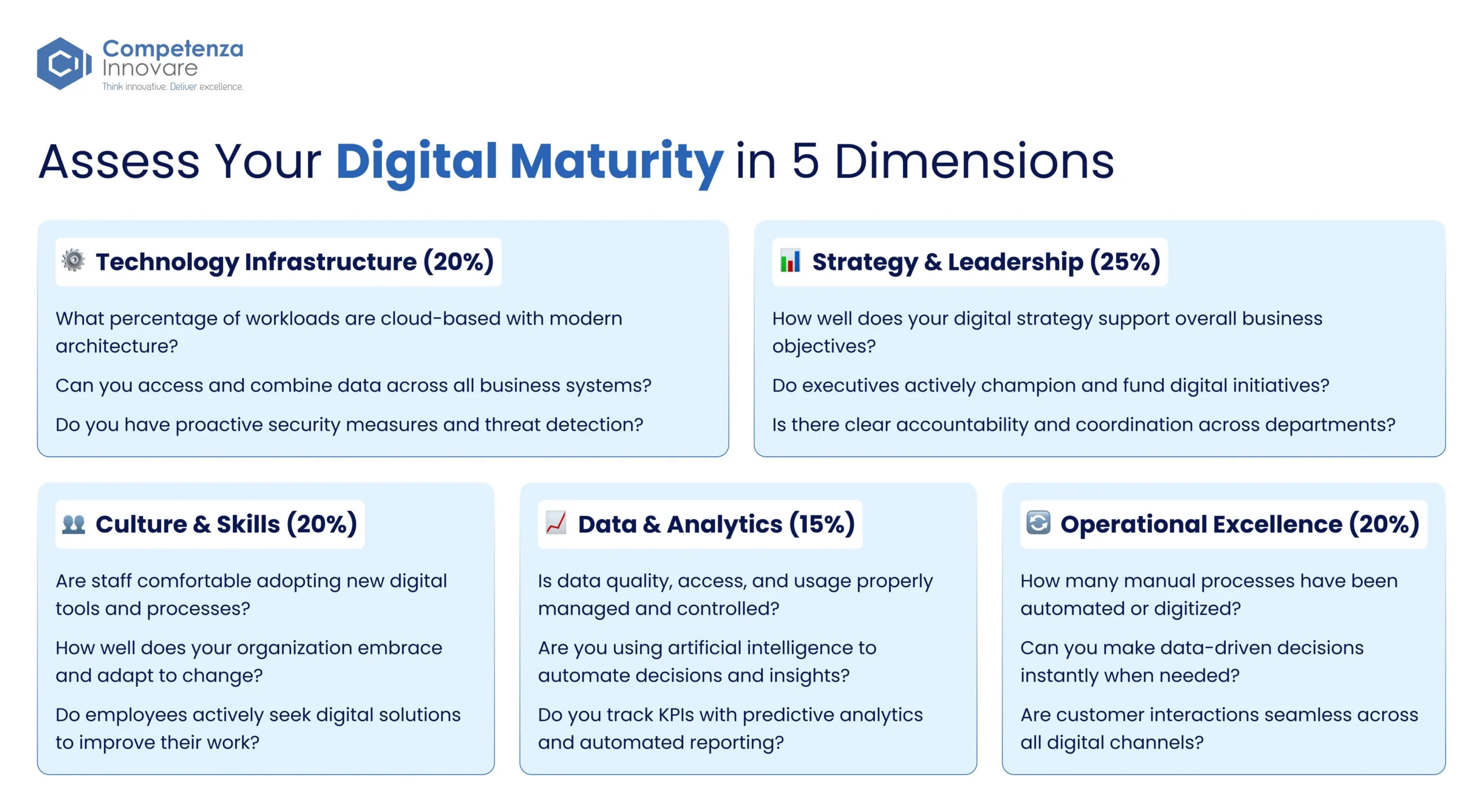
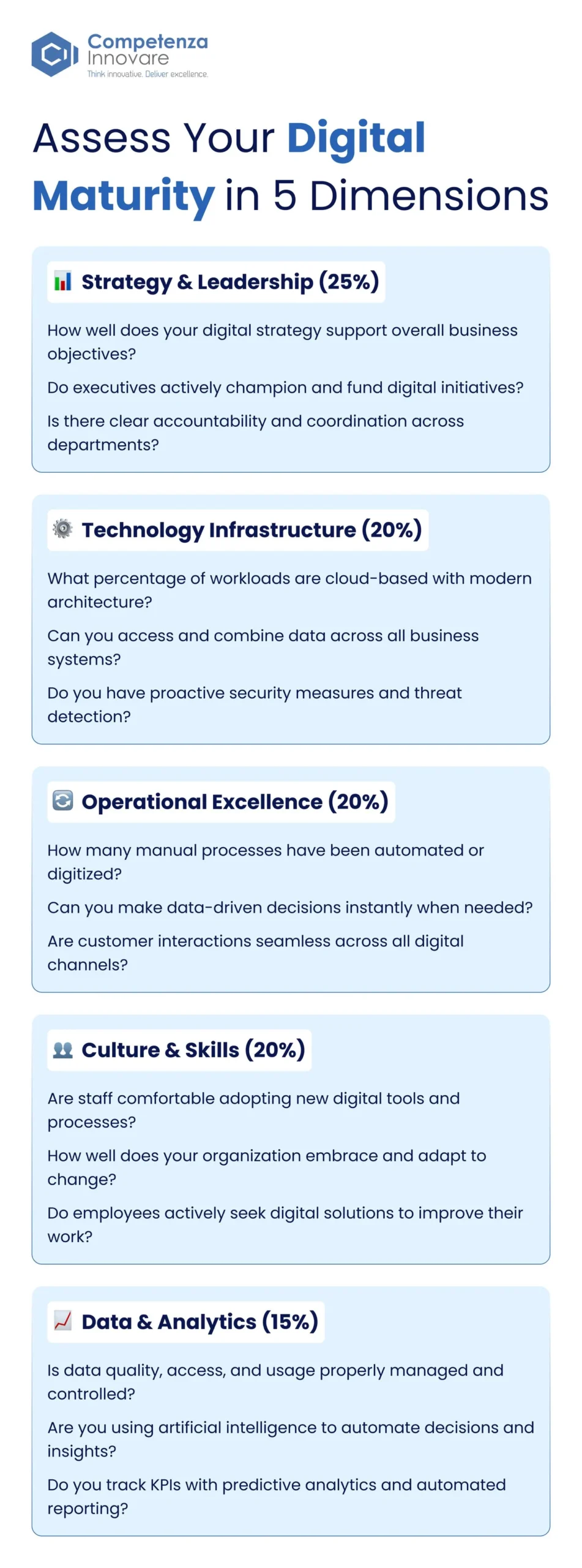
Digital Maturity Levels & Next Steps:
- Level 1 (15-30 points): Digital Beginner Priority: Cloud foundation, basic automation, cybersecurity essentials Investment: $500K-2M annually | Timeline: 12-18 months to Level 2
- Level 2 (31-45 points): Digital Adopter Priority: Process automation, customer experience platforms, data integration Investment: $1M-5M annually | Timeline: 12-24 months to Level 3
- Level 3 (46-60 points): Digital Advanced Priority: AI scaling, advanced analytics, ecosystem integration Investment: $3M-10M annually | Timeline: 18-36 months to Level 4
- Level 4 (61-75 points): Digital Leader Priority: Market innovation, autonomous operations, industry transformation Investment: $5M+ annually | Timeline: Continuous evolution
Benefits of a well-drafted Digital Transformation Strategy
A well-executed digital transformation strategy and a roadmap does more than introduce new technologies.
It outlines the necessary steps to shift from using current digital processes to new ones and aligns the changes with real business needs and measurable impact.
For Middle East businesses, where markets are becoming more digitally driven, a digital transformation roadmap helps in:
- Improving operational efficiency: Automating repetitive tasks and integrating systems cuts down manual errors and accelerates workflows across departments.
- Enhancing customer experience: Personalized digital touchpoints, faster response times, and seamless service delivery are key to improving retention and satisfaction.
- Enabling data-driven decisions: A strategic roadmap ensures data is collected, centralized, and analyzed to inform smarter business decisions.
- Increasing agility and scalability: With a roadmap in place, businesses can adapt to regulatory changes, launch new services faster, and scale their operations with confidence.
- Strengthening market competitiveness: Organizations that align technology with strategic goals can outpace slower-moving competitors and tap into new revenue streams.
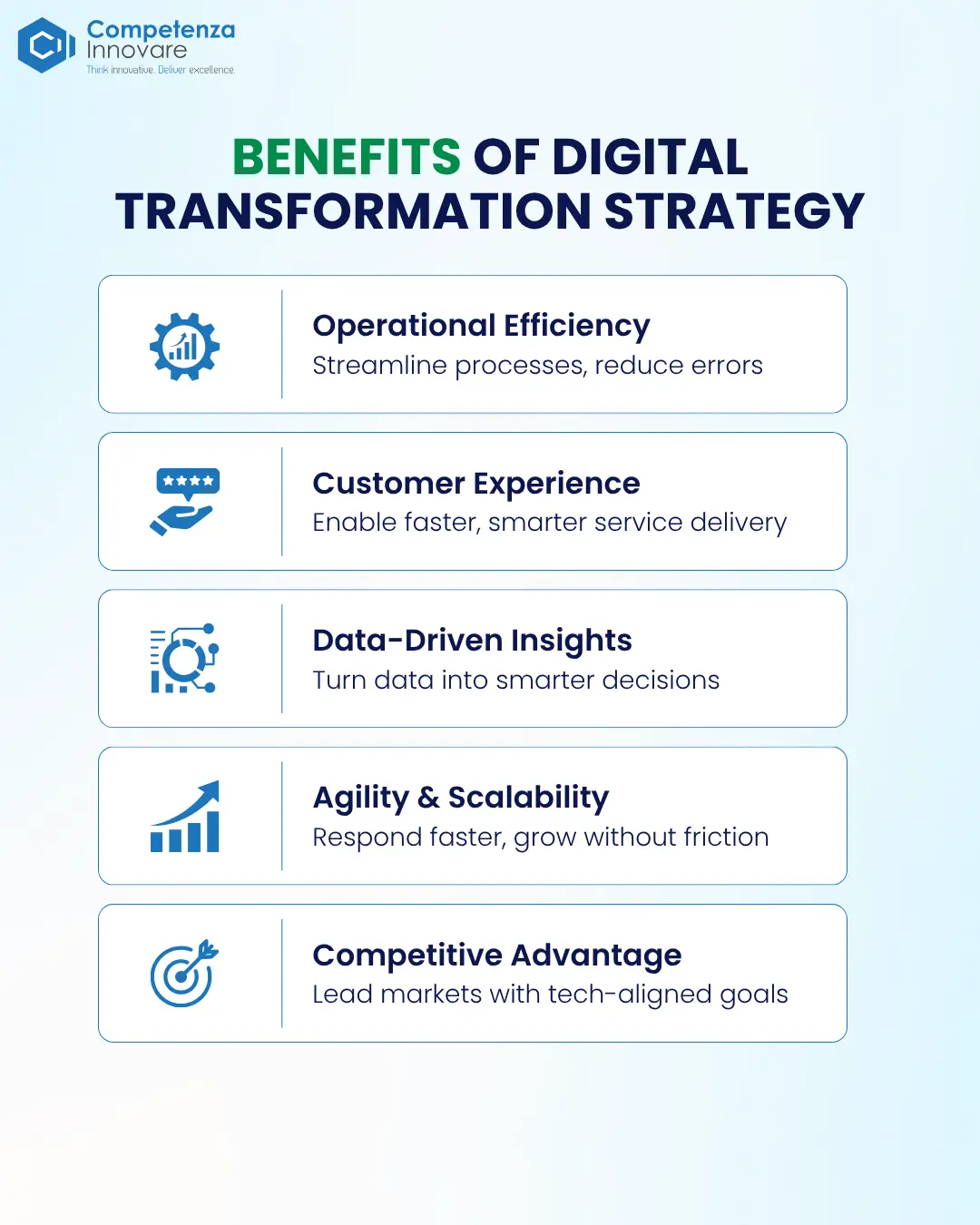
Rise in AI, Cloud, and Automation in the Region
- AI Adoption: 73% of GCC organizations are using AI in business functions, exceeding the global average of 65%, with government and healthcare leading adoption
- Cloud Migration: 90% of regional companies have moved beyond “lift and shift” to cloud-native solutions and application modernization
- Automation Growth: RPA adoption accelerating in GCC, with 53% of businesses globally implementing automation solutions and financial services leading regional adoption
How to Create a Digital Transformation Roadmap
Building a digital transformation roadmap is a multi-step process that takes weeks to months. In this process, businesses align long-term business goals with the right systems, talent, and processes to drive measurable outcomes.
To complete your digital transformation roadmap, consider starting up with these questions for a result-oriented approach.
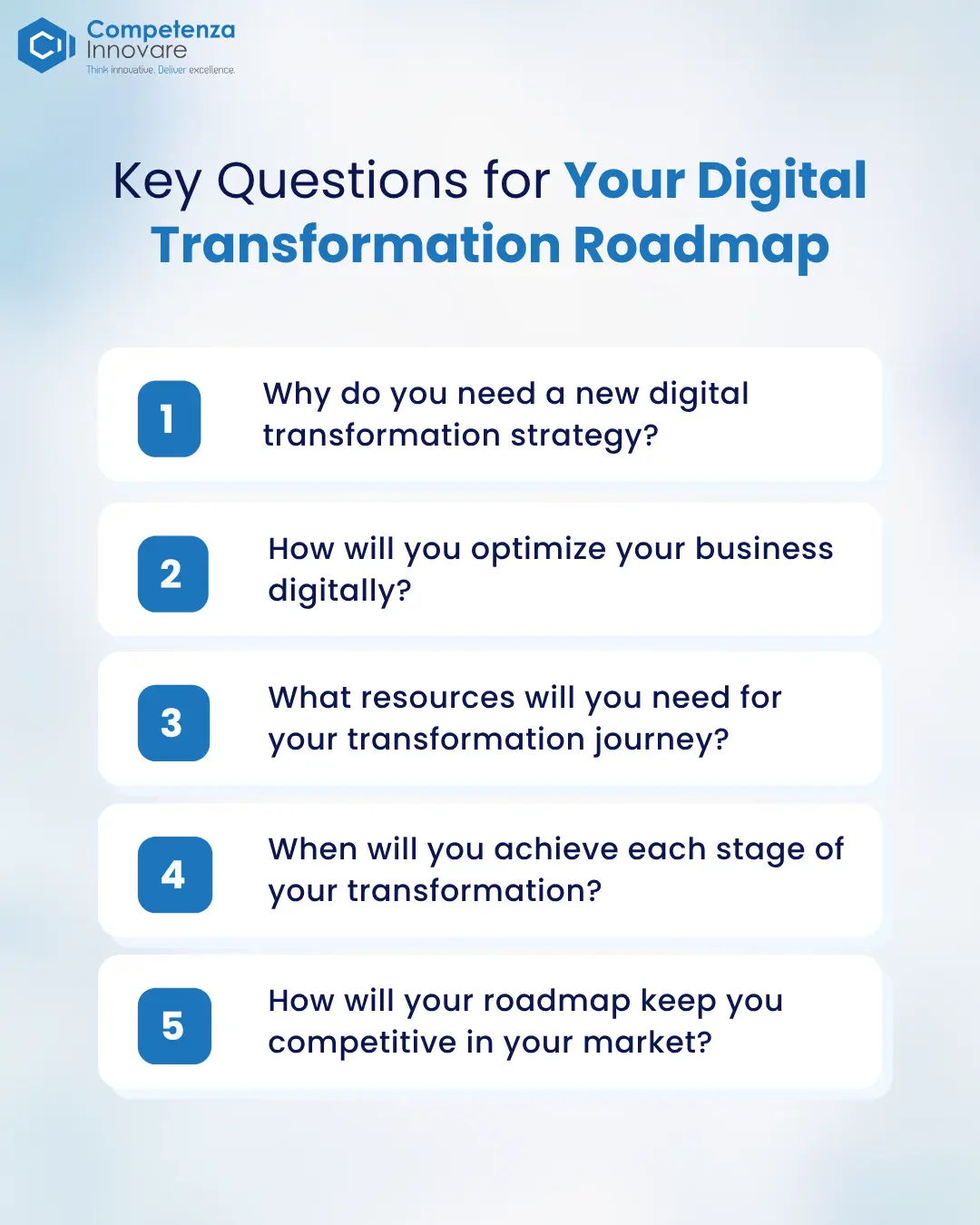
How to Create a Digital Transformation Roadmap in 7 Steps
1. Evaluate Current Capabilities
- Audit all digital assets and operational processes like- ERP systems, customer apps, corporate websites, cloud services, and legacy databases to identify inefficiencies, redundancies, and manual bottlenecks.
- Use tools like digital maturity assessments(check above) and value stream mapping.
- Account for local compliance mandates such as UAE’s PDPL and Saudi Arabia’s NCA regulations when evaluating IT systems.
2. Define Business-Aligned Objectives
- Set digital goals tied directly to operational metrics—reducing service turnaround times, increasing automation in customer handling, or enhancing cross-channel visibility.
- Align targets with regional priorities like the UAE Digital Economy Strategy or Saudi Vision 2030.
- Ensure objectives are time-bound and include success KPIs from day one.
3. Identify Core Tech Transformation Pillars
Here are the foundational areas your roadmap should cover in 2025:
- Cloud Architecture: Move from lift-and-shift to multi-cloud and cloud-native strategies with FinOps optimization.
- AI & ML: Use predictive analytics, natural language processing (NLP), and intelligent automation to enhance workflows and customer experience.
- Data & Analytics: Establish real-time analytics platforms, self-service dashboards, and strong data governance.
- Automation: Deploy RPA, intelligent document processing, and hyperautomation combining AI and ML.
- Cybersecurity: Build a zero-trust architecture, embed AI-based threat detection, and maintain business continuity plans.
4. Secure Executive Ownership
- Assign transformation leadership to a C-level champion (CDO, CIO, COO) with budget control and decision-making authority.
- Use data-backed forecasts to gain support—such as process improvement benchmarks or competitive insights.
- Showcase successful examples from similar sectors in the GCC to strengthen the case.
5. Build a Cross-Functional Taskforce
- Include tech leads, operations heads, and regional compliance advisors in the core team.
- Where skills are lacking, consider IT staff augmentation or outsourcing to experienced transformation consultants.
- Define clear ownership and communication channels to avoid delays and misalignment.
6. Launch High-Impact Pilots
- Select use cases with clear ROI potential, like invoice automation, customer onboarding digitization, or analytics dashboards.
- Limit initial scope to ensure speed and visibility—target results within 90 days
- Use pilots as proof of concept before scaling to enterprise-wide deployment.
7. Drive Change Through Culture
- Roll out internal campaigns to explain the strategic intent and benefits of transformation to all stakeholders.
- Provide digital training pathways focused on tool adoption and agile workflows.
- Encourage champions at every level to share quick wins and user success stories.
8. Monitor, Optimize, and Scale
- Track initiatives using dashboards and feedback loops for agility and transparency.
- Evaluate each initiative quarterly—retire what’s not working and double down on what is.
- Document learnings and create replicable playbooks for scaling transformation across business units.
Key Considerations for Middle East Businesses Before Building a Digital Transformation Roadmap
- Align With Business Goals: Make sure every transformation initiative clearly supports long-term strategic outcomes, like growth or efficiency.
- Secure Executive Support: Ensure leadership actively backs your roadmap. Their commitment speeds up decision-making and resource allocation.
- Check IT Readiness: Assess infrastructure and data systems early. Weak digital foundations can stall progress and raise costs.
- Understand User Impact: Plan for employee training and clear communication to minimize disruption and resistance.
- Compliance and Regulation: Include regional regulations (UAE PDPL, KSA cybersecurity) in your roadmap from day one.
Common Mistakes to Avoid while Building a Digital Transformation Roadmap
Even the most ambitious transformation initiatives can fail if not carefully planned and executed.
Overlooking foundational strategy and execution details can waste efforts & resources and stall progress.
Here are some common missteps businesses in the Middle East should avoid:
- Unclear Objectives: Starting without clear, measurable goals leads to confusion and wasted effort. If the technology adopted doesn’t directly support core business outcomes—efficiency, customer experience, or market growth, the initiative will underdeliver.
- Underestimating Change Management: Ignoring the human elements like employee resistance, lack of training, etc, can severely slow adoption.
- Trying to Do Everything at Once: Businesses sometimes try to digitize every function simultaneously. This dilutes focus and creates resource bottlenecks. A phased approach aligned with business priorities works better.
- Unclear Success Metrics: Without defining what your end goal would look like, KPIs tied to user adoption, efficiency gains, or revenue impact, organizations struggle to measure their digital transformation journey.
- Neglecting Iteration and Feedback: Skipping regular check-ins prevents quick adjustments and slows the momentum.
Digital Transformation Success Stories in the GCC Countries
Across the GCC, government-backed digital initiatives are reshaping the region’s business landscape, setting the tone for how organizations approach their own digital transformation strategies.
These initiatives serve as both inspiration and blueprint. For businesses across the region, aligning with national digital goals is becoming necessary for long-term relevance.
- Dubai’s Smart Government Strategy: Dubai has positioned itself as a global digital leader through its Smart Dubai initiative. From blockchain-powered services to AI integration in public utilities, the emirate is pushing the boundaries of e-governance and digital citizen engagement.
- Saudi Arabia’s Vision 2030: Saudi Arabia is accelerating its digital capabilities through programs like the National Digital Transformation Unit. Sectors such as health, education, and finance are being redefined through cloud adoption, smart infrastructure, and AI-led systems
- Qatar’s Smart Nation Drive: Qatar’s Smart Program, driven by the Ministry of Communications and Information Technology, is enhancing digital infrastructure across public services, transport, and urban planning. It signals a long-term commitment to building a tech-driven economy
How Competenza Supports Digital Transformation for Middle East Businesses
Competenza has helped several organizations in the Middle East translate their digital ambitions into real, measurable outcomes.
Whether you need a full roadmap, implementation support, or digital strategy consulting, our team supports every stage of your digital transformation journey.
- Tailored Roadmap Planning: We co-develop digital transformation strategies tailored to sector-specific needs and considering compliance, scalability, and technology maturity.
- Full-Stack Engineering Expertise: From modernizing legacy systems to developing cloud-native solutions, our team brings deep technical expertise across cloud, mobile, data, and AI.
- Modular Engagement Models: Depending on your business needs, we offer end-to-end execution or team extensions. Our flexible models allow you to scale efforts without disrupting core operations.
- GCC Market Alignment: With years of experience in regions like Saudi Arabia, Dubai, Kuwait, Bahrain, and other GCC regions, we ensure all solutions meet regional regulations and expectations.
Connect for a free digital transformation consulting session with our experts to begin the digital transformation journey in your organization.
Conclusion: Digital Transformation as Key to Business Resilience and Growth
Digital transformation in the Middle East isn’t just about catching up—it’s about leading the next generation of business innovation.
With strong national agendas, increasing AI adoption, and scalable cloud technologies, there’s never been a better time to build your digital transformation roadmap.
In 2025 GCC digital transformation is being shaped by rapid urbanization, ambitious national visions, and a digitally aware population.
This presents significant opportunities in areas like- digital health, smart projects, eCommerce, fintech, edtech, cybersecurity, and digital literacy.
A well-defined digitalization strategy helps businesses stay aligned with broader business goals, evolving market dynamics, customer expectations, and operational challenges.
The most successful businesses in 2025 will be the ones that start preparing today.
FAQs
1. What are the first steps to building a digital transformation roadmap in the Middle East?
The first step to building a digital transformation roadmap is assessing your current business landscape. This includes evaluating existing business processes, technology gaps, and workforce readiness. Businesses in the Middle East, especially in regions like the UAE and Saudi Arabia, should align their roadmap with national digital strategies such as KSA Vision 2030 or Smart Dubai. Clearly defining objectives, identifying key performance indicators (KPIs), and involving leadership early on ensures that your transformation strategy is grounded in regional goals and business realities.
2. How long does it typically take to see results from digital transformation initiatives?
The timeline to see tangible results from a digital transformation roadmap varies depending on the complexity of the business and the technologies involved. On average, Middle East enterprises begin to experience operational improvements within 6 to 12 months of implementing key initiatives. However, large-scale transformation programs may span several years. Businesses should track incremental progress through defined milestones and ensure adaptability to evolving market and customer demands in the GCC region.
3. How can SMEs in the Middle East afford digital transformation?
Small and medium enterprises in the Middle East can afford digital transformation by prioritizing scalable and cost-effective technologies such as cloud computing, SaaS tools, and low-code platforms. Government-backed initiatives like the UAE’s Digital Economy Strategy and KSA’s SME support programs offer funding, training, and incentives for digital innovation. Many IT partners in the region also provide modular engagement models, allowing SMEs to start small and expand their digital capabilities over time without heavy upfront costs.
4. What’s the difference between a digital strategy and a digital transformation roadmap?
A digital strategy defines the overarching vision and objectives for how a business will compete and thrive in a digital environment. In contrast, a digital transformation roadmap is the execution plan that outlines specific steps, timelines, and technologies needed to achieve that vision. The digital transformation roadmap translates strategy into actionable initiatives aligned with local market trends, customer behaviors, and regulatory requirements. Both elements are essential to driving sustainable digital growth.
5. What technologies should be prioritized in 2025 for digital transformation in the Middle East?
Technologies that should be prioritized in 2025 include AI and machine learning for automation and analytics, cloud platforms like AWS MENA and Microsoft Azure UAE for scalable infrastructure, and cybersecurity tools compliant with regional data protection laws. Digital payment solutions, customer experience platforms, and ERP integrations also remain critical. Businesses in sectors like healthcare, logistics, and retail should tailor their technology stack based on sector-specific needs and GCC digital maturity benchmarks.
6. How do I measure ROI on digital transformation?
Track baseline performance, set milestone KPIs, and use dashboards to monitor financial, operational, customer, and employee outcomes.

 Dista
Dista